Recipe Ideas
Cooking above 4000 m.
Water boils at insufficient temperature to cook rice or ordinary noodles. Both
these will turn to mush before they are done. We have heard two stories of cyclists
in Tibet buying 3 weeks supply of rice, then being unable to cook it.
There are two possible solutions. If you will be high for a short time (2 weeks
in our case), Packet noodles are precooked, so present no problems other than
the need to resist adding all 3 flavour sachets and converting food into pot
noodle. The other solution is heavier. Buy a small pressure cooker. These I
am told can be found in Llasa, although we only saw large ones in Sichuan. All
the locals use them for rice, noodles and boiled veg.
Shishka pine cones
 |
A herder in the Tuva republic of Siberia gave us a pine cone and showed
us how to peel back the leaves to reveal pine nuts. I have heard they also
grow in Corsica. |
 |
I spent the next day exasperating Mark, by stopping to examine every likely
looking tree. I found that the cones grow at the ends of the upper branches
of pine trees with rounded tops and long needles. These trees grow only
above 1000m on the mountains. |
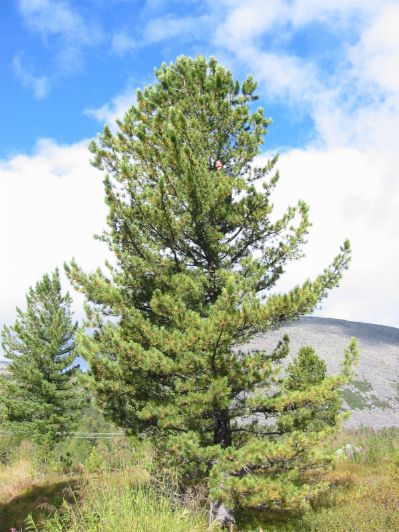 |
The next stage is to reach the cones. (Spot the English cone hunter).
A local man told me that the Russian Army bang the tree using 6 strong
men and a spare tree trunk. Lacking the men they dynamite the tree base.
We however saw local men gently swaying in the tree tops picking the cones.
The cones are covered in resin. One local person told us that we should
boil them to remove the resin, but better I think is to roast the whole
cone over the fire on a toasting rack. The nuts come out more easily then.
Each cone takes about as long to eat as an lobster.
|
Toast
 |
Josie Dew and other notable cycle tourists rave about the joys of porridge
for breakfast, but for me no sticky mess can compare with crisp toast,
cream and honey. Mark has used his plier-like grip to shape a bit of steel
wire we found into a toasting rack. It is also good for grilling fish.
The rack has two butterfly wing loops , with the end bent upwards to
form a hook. The upright hook must be long or the rack tilts too much
as you take the first piece off, throwing it's partner onto the coals
below.
|
Leg of Lamb
We got this leg of lamb from a trader selling one freshly buchered sheep at
a market in the Altai mountains. Much hacking up was needed to get it into the
pot. Being a biology teacher I was reminded of dissections and made investigations
of knee and elbow ligaments. This did not in any way reduce the pleasure of
eating it. We had it fried, grilled, souped and casseroled. Mark applied some
stone age technology to the bones to fit them into a pan to make boullion. All
3 kg came for less than price of 3 kg of potatoes. There are lots of sheep here.
A taste of home
Many 'English persons abroad' thirst for 'real' tea or dark beer, but I like
weak tea and prefer Baileys to beer. No what I miss is chip shops. Some find
solace by visting McDonalds and never admitting it to any fellow travellers,
but those spindly mouse portions of 'freedom fries' really don't cut the mustard
for me. Just yesterday I satisfied my cravings by turning a tranja pan into
a deep fat frier on the petrol stove. I fried everything in the paniers; Fat,
juicy potato chips, carrot chips, aubergenes ect. The only thing lacking was
a Haggis to fry for that real taste of scotland. My friends in the Cambridge
Climbing and Caving club would be horrified to think of my in charge of a full
pan of hot oil on a wobbly petrol burner. The dangers are obvious, but Mark
is so pleased with the calorific quality of the results that it is worth the
risk.

A second, linked breakthrough is crisp manufacture. In Russia, they only sell
nasty flavoured crisps at high prices. Honest salted ones are impossible to
find. Now I make them: Cut the potatos, carrot or beetroot as finely as is humanly
possible and simply fry.
Ideas from a siberian Dacha
The leaves of blackcurrent bushes boiled for about 10 minutes make a refreshing
tea
Cucumbers sprinkled with a bit of salt are nice with beer.
Marrows are surprisingly tasty as part of a ratatoui.
Kisslatka and Custard from the Ural mountains. (June)
Kisslatka has a juicy stalk, with a taste just like Rhubarb. It grows about
700m in mountain forests. Locals collect it to sell on the market in May and
June, when there are few other greens about. I pull off the leavess and the
fibrous outer layers, then cook with lots of suger and a bit of water, like
Rhubarb. Condensed milk is an available substitute for custard.
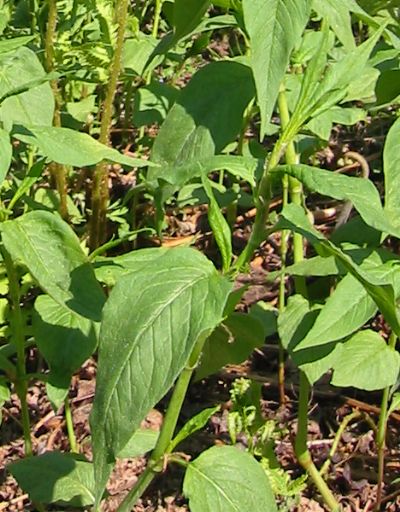
Fish cakes (recipe from Mum)
Potatos are very expensive to cook on the Trangia in terms of meths and water
needed not to mention pedal power to transport. I like to have them every so
often however on a long tour as they have vitamin C that rice or pasta lacks.
So I always cook a pan brimming full of them. The left over ones get mashed
and put in a box. In the morning mash with any sort of tinned fish and other
left over veg, coat in flour and FRY.
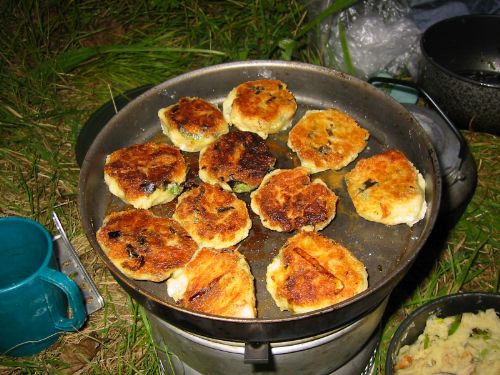
Blackberry and Elderberry pancakes (Late August and Sept)
The first advantage of the recipe is the collection. You have the perfect excuse
to stop for a rest at any laden bush. Have the Tupperware box at the ready.
Pick the blackberries without stalks, but the elders by the bunch.
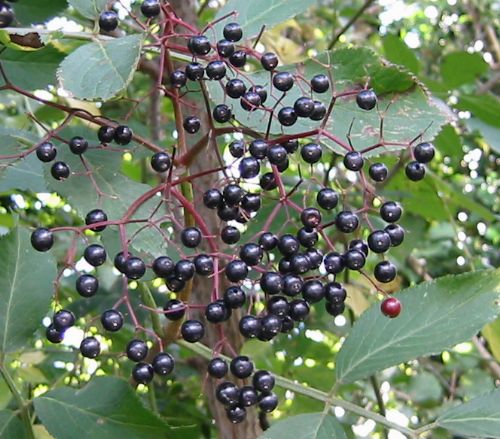
Pull the elderberries off their stalks into a pan. Add lots of sugar and a
tiny bit of water and some mixed spice if you want more interest.. Cook until
berries start to mush. These have a powerful flavour rolled into pancakes (100%
lovely), with custard (98% lovely), In porridge (anything to improve it, PS.
use as a topping rather than mixing unless you area fan of sunny delight and
other things which do not appear to have earthly colouration).
You can also strain of the juice, but you will lose lots in the pulp unless
you have a tendancy to cycle around in tights which can be used to strain the
mixture overnight. The juice makes a powerful cordial.
WARNING: Don't pick near very busy roads as there is a risk that the plants
have picked up pollutants.
The juice stains clothes, so wear dark colours.
Fish picnic
Good for coastal areas where you pass fishmongers en route.
Fresh sardines are intirely different to the tinned variety. Buy about 6 per
person, coat them in flour and fry them whole. The bones are so soft I eat them
whole except for the head. The tails a really nice and crispy.

Chestnuts Late sept, oct, early nov.
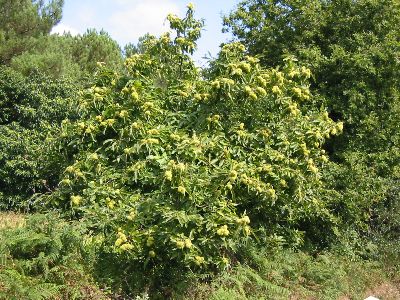
The Hills at a hight of 200 to 800 metres around the massif central are full
of nuts in October. Chestnuts and hazels abound on the side of any small road.
There are also walnuts, but most of them seem to have owners.
Cracking
The SPD cleats of cycling shoes are ok for stamping on the nuts, but it requires
skill or you end up scraping bits of macerated nut off the road. Much better
is to borrow some knowledge from prehistory and use 2 rocks. One big flat one,
preferably with a bit of a dent in the middle and another just smaller than
a shot put, so you can grip it and hit the nut without smashing your fingers.
Roasting (ok for very remote places where a small cooking fire would not offend
land owners and where risk of fire from sparks is not too great)
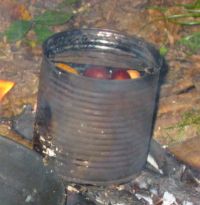
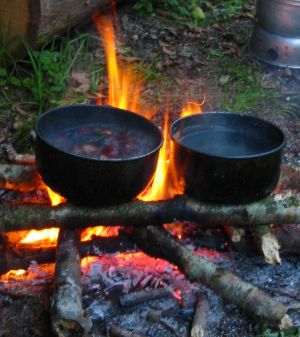
Throw chestnuts into a used tin can and stick it on an open fire. Oh yes and
don't forget to pierce each one first or they explode. Leave about 10 mins.
until they are just a bit blackened on the outside.
Boiling
Sounds nasty, but works well. Boil the chestnuts whole over the tranja for
10 to 15 mins. Throw away the water. The next bit takes a while. Hollow out
each nut with a teaspoon, or if you have any nails (Idon't) then peel them.
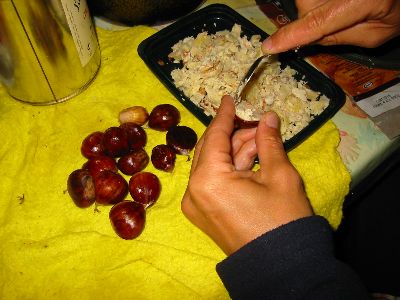
The nut is nice in : Fish patties, or to thicken stews. I also want to try
using it for patties made of onion, chestnut, egg and flour or a bit of potato.
The only trouble is we have passed onto higher ground without chestnut trees.
Perhaps the Ardeche Gorge will have some.
Chestnut patties are very good, only add garlic sausage chopped up and a bit
of cumin Boil and hollow out the nuts the day before and keep them in the tupperware
box so they don't take so long to make.
Rosehip syrup (November)
This is high in vitamin C and easily available at a time where otherfriuts
are finished. Rosehips are abundant in Britain and on the hills of Italy.
Pick a quarter of a carrier bag of hips. The best ones will be softened by
frost, but hard ones will do
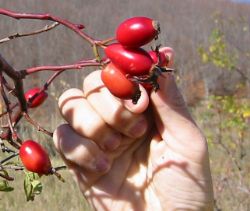 Bend the hip sudeways
to pick, rather than just pulling on it as this avoids the recoil of thorny
branches into your hands or face.
Bend the hip sudeways
to pick, rather than just pulling on it as this avoids the recoil of thorny
branches into your hands or face.
Boil the hips in a few cups of water and a heap of suger for 10 mins or so,
then mash with the bottom of a mug. Avoid contact with the mixture at this stage,
as the fibres in the hips stick in the skin and cause irritation. (A fact I
discovered the hard way as a greedy child when I tried to eat the hips raw from
a garden on the way home from school)
The next step is traditionally to strain the mix through a pair of tights,
but since I don't wear tights on the bike or indeed ever, I use an old rag.
A sock would also do if you could stomach it.
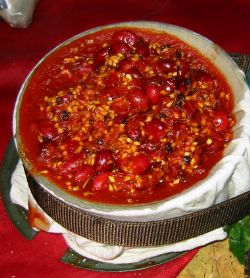 The rag can be washed
out and reused or returned to your store of chain cleaning rags if you decide
you don't like the syrup and don't want to make it again.
The rag can be washed
out and reused or returned to your store of chain cleaning rags if you decide
you don't like the syrup and don't want to make it again.
The syrup keeps well in a pop bottle and is nice as a long drink with water
hot or cold. No doubt the South American traveller could mix it with cane alcohol
to make a far less healthy beverage
Medlar cordial
I spotted trees bearing this fruit in several Italian gardens and figured that
they may be edible. Thanks to Ingrid I now know that they are medlars and that
they are indeed edible. When I saw some growing wild on an abandoned terrase,
I had to try them. (Looks like things have not changed all that much from those
rosehip eating days)
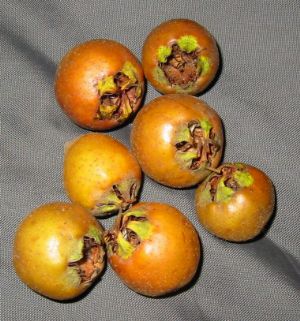
I chopped these finely and boiled them with sugar, then strained off the liquid
through the strainer disk to drink. They really taste very good and gave no
tummy trouble.
Another mystery fruit
This was found growing on a vine with squash type leaves, that had draped itself
over an olive tree. It tasted of very little, was crisp and watery. Frying it
was not successful, but it was ok in stew.
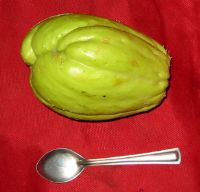
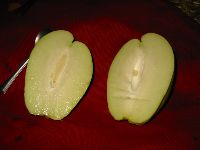
Thankyou to Gavin Jowitt, who tells me that in Oz this fruit is a Choko.
I have yet to look up recipes for it.
A flask drink for winter in Romania
Tea and coffee are nice, but not ideal in a contiually used flask. They are
also poor for hydration, as they are diuretics. Lemon and vineleaf tea is much
better.
For a 0.7 litre flask: One herbal tea bag, 5 heaped spoons of sugar, lemon
juice (available in every shop very cheaply), to a depth of 1 cm in the flask
lid. The tea gets stronger over the day, but this improves it, rather than stews
it
Romanian cheesy Polenta
The guide book describes this as a tasteless mush, but I like it in moderation
as a substitute for mashed potato.
1) sprinkle polenta into boiling salted water, stirring continuously.
2) Simmer for a few minutes, then take off the heat and cover. For more interest
a tin of peas or sweetcorn is tasty if you are not influenced by the appearance
of your food (looks a bit puky).
In cold weather and if you have a synthetic sleeping bag, you can put the pan
in a stout plastic bag in your sleeping bag to keep it warm.
3) By the time you have fried the sausages, the polenta is ready. Just serve
with a triangle of processed cheese melted on top. Of course sour cream is a
much better and authentic topping, but not as easy to come by as cheeese in
Romania.
Ukrainian spring salad and other regional goods
Our Ukrainian friend Vlad showed me this simple idea based on the only two
sorts of vegetable readily available in the Ukraine in spring:
1) Mayonaise (Small packets are sold in every shop)
2) Tin of sweetcorn
3) Chopped radishes and cucumbers. MIX
Sour cream (Smetana), is quite easy to get here, but jam is almost impossible.
We replaced bread and jam for breakfast with bread topped with spicy marrow
preserve and sour cream. The marrow preserve is like highly concentrated soup,
with a picture of vegetables and marrows on the jar.
Ju's index





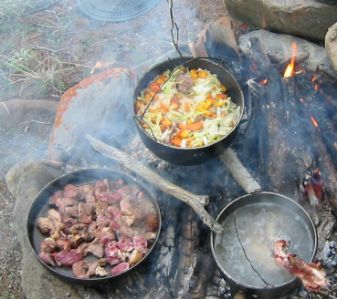









 Bend the hip sudeways
to pick, rather than just pulling on it as this avoids the recoil of thorny
branches into your hands or face.
Bend the hip sudeways
to pick, rather than just pulling on it as this avoids the recoil of thorny
branches into your hands or face. The rag can be washed
out and reused or returned to your store of chain cleaning rags if you decide
you don't like the syrup and don't want to make it again.
The rag can be washed
out and reused or returned to your store of chain cleaning rags if you decide
you don't like the syrup and don't want to make it again.

